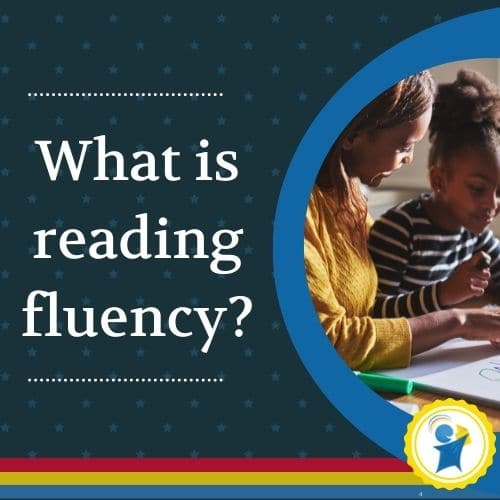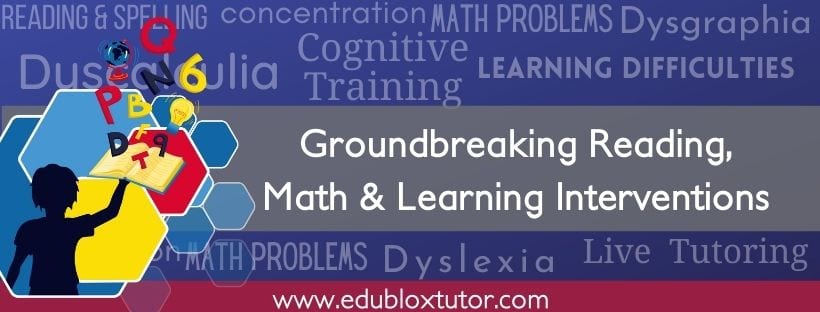
Reading fluency gained prominence when it was included as one of five essential reading skills in a national-level research synthesis on reading instruction. Reading fluency is the ability to read with speed, accuracy, and proper expression. In order to understand what they read, students must be able to read fluently, whether they are reading aloud or silently.
There are a variety of preparatory and supportive fluency skills. One is the ability to decode words, i.e., to apply your knowledge of letter-sound relationships and letter patterns and correctly pronounce written words.
However, sounding out or decoding every word can take a lot of effort. Therefore, reading fluency requires effective word recognition skills. Word recognition is the ability to recognize whole words instantly by sight without sounding them out.
Decades of research indicate that fluency is one of the critical building blocks of reading because fluency development is directly related to comprehension. Below are the results of a study by Fuchs et al. that shows how oral reading fluency correlates highly with reading comprehension.
| Measure | Validity Coefficients |
|---|---|
| Oral Recall/Retelling | .70 |
| Cloze (fill in the blank) | .72 |
| Question Answering | .82 |
| Oral Reading Fluency | .91 |
To interpret the correlation data, consider that a perfect match would be 1.0. As you can see, oral recall/retelling, fill-in-the-blank, and question answering are all above 0.6, indicating a strong correlation. Oral reading fluency is by far the strongest, with a .91 correlation.
Reading fluency is a synthesis of three factors
In the literature on reading and cognition, reading fluency is treated as a synthesis of three related factors:
- Speed/Pace: Good reading must be fairly quick. If you read too slowly, your short-term memory cannot hold onto the information from the beginning of a passage to the end. This is a problem because you need to access all the information to draw the conclusion the writer wants you to. The most common unit of measurement for reading pace is words per minute.
- Accuracy: Inaccurate reading is useless, at best. If you are a proficient reader, you have an extensive repertoire of words that you can treat as sight words. These are words that you recognize without the need to decode them. At an even higher level, you are able to take in entire chunks of language at a time.
- Prosody: The third factor that undergirds fluency in reading is prosody. This term refers to things such as rhythm, pitch, and tone. For example, when you ask a question, you may raise your voice slightly as you approach the end. To read effectively, you need to be able to “hear” the text and apply the corresponding features, even when you read silently.
Ways of measuring reading fluency
Because of its complexity, fluency is not easy to measure. As a result, there are various approaches, with different tests using different methods to assess how fluently a child reads. Generally, three factors vary between tests: oral/silent, real/pseudowords, and in-context/out-of-context.
- Oral or silent: A test might require a child to read out loud or silently. Reading aloud is slower than silent reading but easier to measure. It’s also a more realistic reflection of a child’s reading ability because you can hear prosodic features such as tone and rhythm.
On the other hand, asking the child to read silently has the advantage of focusing strictly on the pace of the reading. Ideally, both should be measured because variances between the two can be salient in and of themselves.
- Real words or pseudowords: This distinction comes up quite often in dyslexia testing. At first glance, it might seem strange to ask children to read words that are not part of their language. But this may be very useful because when you encounter a “nonsense” word, you can’t rely on your word knowledge or the context to identify it. Instead, you must rely on your knowledge of sound/symbol relationships and spelling rules. This is precisely the knowledge dyslexics struggle to incorporate, so it makes sense to target it directly.
However, some tests opt for real words because a child’s awareness of meaning will impact their performance on a reading assessment. For example, a child might successfully decode a pseudoword but hesitate because the word does not correspond to anything they understand. This can yield a skewed result.
Another undesirable consequence of using pseudowords is that they can create uncertainty in the reader’s mind. A child might come to believe that a nonsense word is, in fact, a real one. For these and other reasons, many practitioners object to the use of pseudowords. However, they remain pretty common in dyslexia tests.
- In context or out of context: Many fluency tests utilize lists of words free of any context. The reader must move vertically down the list rather than horizontally, as with continuous text. The logic behind this is simple: the test wants to measure the speed and accuracy of word recognition. Giving a context allows other skills to enter the picture. For example, you might correctly “guess” an unknown word by using the context around it, using clues or strong associations between words. Consider the following example:
“It’s important to have a balanced ____ .” You probably had no difficulty inserting “diet,” because this word strongly associates with “balanced.” It’s even easier if this topic has occupied your mind recently.
Fluency tests that give words out of context aim to eliminate the interference of these meta-linguistic skills. On the other hand, fluent reading is always contextual in the real world. In other words, when we read, we do make use of the immediate context in order to make quick judgments.
Given all of these differences, there is an array of tests that practitioners can choose from when assessing reading fluency. Here are some of the more popular and well-established tests that might feature in your child’s assessment:
Tests that measure reading fluency
Gray Oral Reading Test (GORT-5)
Assessors use this test to gauge how accurately and fluently a child reads. It’s appropriate for people between 6 and 24 years of age. The test comes in two forms (A and B), which allows the practitioner to calibrate it to the needs of a particular child. The format of the test is simple; there are 16 stories with questions after each one. The results are precise, and the assessor can derive a score based on the following:
- Rate: This score comes from measuring the time a child takes to read the story. Reading is done out loud to make this possible.
- Accuracy: The number of correctly pronounced words goes into a calculation of accuracy.
- Fluency: From these two, the assessor can derive a fluency index, which collates the rate and accuracy. For many dyslexic children, rate and accuracy are in tension: fast reading is inaccurate, and accurate reading is slow. This test can provide a clear picture of the imbalance and give subsequent therapists a basis for developing a treatment plan.
Test of Word Reading Efficiency (TOWRE-2)
TOWRE is useful in assessing decoding ability. But it is also informative for the clinician who wants to ascertain reading fluency. This test utilizes word lists to measure fluency. One list uses actual words (Sight Words), and the other uses pseudowords (Phonemic Decoding). For both tests, the words are out of context and oral. Children have 45 seconds to read as many of the words as possible. Then, the clinician notes the number of correct pronunciations and generates a score accordingly.
Test of Silent Word Reading Fluency (TOSWRF-2)
Silent Word Reading Fluency (TOSWRF) utilizes silent reading. This is a quick test, lasting either three or six minutes. Each form takes three minutes, and the assessor may use two. The test is also suitable for group or individual administration because it does not require reading aloud. The child reads rows of words with no spacing between the words. The rows grow progressively more difficult. The task is to draw lines to mark where one word ends and another begins. The number of accurate lines the child draws in three minutes yields the score. The words in this test are out of context but all real.
Wechsler Intelligence Scale for Children (WISC-V) Oral Reading Fluency Subtest
This subtest of the WISC-V battery of tests aims to assess all three aspects of fluency: accuracy, speed, and prosody. To complete the test, the child reads two different texts. Once they reach the end of each text, the examiner asks a comprehension question, but this is not evaluated. The purpose is simply for the child to read with comprehension. The score for accuracy comes from the accuracy rate on both texts. The score for speed is based on the amount of time the child takes to complete the task. The examiner then adds an evaluation of prosody after having observed the child read.
Is poor reading fluency holding your child back?
Edublox Online Tutor is an online platform that houses a range of products and services to improve literacy skills. Our programs include Development Tutor, Reading Tutor, and Live Tutor. Live Tutor works in conjunction with Development Tutor and is recommended for students with mild to severe reading difficulties, including dyslexia. Edublox aims to develop preparatory and supportive reading skills, fluency, and comprehension.
Watch our playlist of customer reviews and book a free consultation to discuss your child’s reading needs.

